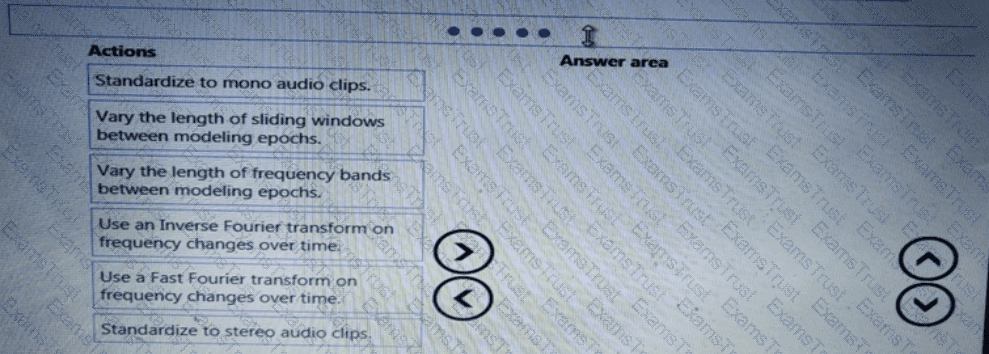You manage an Azure Machine Learning workspace. You design a training job that is configured with a serverless compute. The serverless compute must have a specific instance type and count
You need to configure the serverless compute by using Azure Machine Learning Python SDK v2. What should you do?
You create an Azure Machine Learning pipeline named pipeline 1 with two steps that contain Python scnpts. Data processed by the first step is passed to the second step.
You must update the content of the downstream data source of pipeline 1 and run the pipeline again.
You need to ensure the new run of pipeline 1 fully processes the updated content.
Solution: Change the value of the compute.target parameter of the PythonScriptStep object in the two steps.
Does the solution meet the goal'
You train a classification model by using a decision tree algorithm.
You create an estimator by running the following Python code. The variable feature_names is a list of all feature names, and class_names is a list of all class names.
from interpret.ext.blackbox import TabularExplainer

You need to explain the predictions made by the model for all classes by determining the importance of all features.
For each of the following statements, select Yes if the statement is true. Otherwise, select No.
NOTE: Each correct selection is worth one point.

You plan to use the Hyperdrive feature of Azure Machine Learning to determine the optimal hyperparameter values when training a model.
You must use Hyperdrive to try combinations of the following hyperparameter values:
• learning_rate: any value between 0.001 and 0.1
• batch_size: 16, 32, or 64
You need to configure the search space for the Hyperdrive experiment.
Which two parameter expressions should you use? Each correct answer presents part of the solution.
NOTE: Each correct selection is worth one point.
Note: This question is part of a series of questions that present the same scenario. Each question in the series contains a unique solution that might meet the stated goals. Some question sets might have more than one correct solution, while others might not have a correct solution.
After you answer a question in this section, you will NOT be able to return to it. As a result, these
questions will not appear in the review screen.
You are creating a model to predict the price of a student’s artwork depending on the following variables: the student’s length of education, degree type, and art form.
You start by creating a linear regression model.
You need to evaluate the linear regression model.
Solution: Use the following metrics: Relative Squared Error, Coefficient of Determination, Accuracy, Precision, Recall, F1 score, and AUC.
Does the solution meet the goal?
You create an Azure Machine Learning workspace.
You must configure an event handler to send an email notification when data drift is detected in the workspace datasets. You must minimize development efforts.
You need to configure an Azure service to send the notification.
Which Azure service should you use?
You use Azure Machine Learning studio to analyze a dataset containing a decimal column named column1. You need to verity that the column1 values are normally distributed.
Which static should you use?
You plan to explore demographic data for home ownership in various cities. The data is in a CSV file with the following format:
age,city,income,home_owner
21,Chicago,50000,0
35,Seattle,120000,1
23,Seattle,65000,0
45,Seattle,130000,1
18,Chicago,48000,0
You need to run an experiment in your Azure Machine Learning workspace to explore the data and log the results. The experiment must log the following information:
the number of observations in the dataset
a box plot of income by home_owner
a dictionary containing the city names and the average income for each city
You need to use the appropriate logging methods of the experiment’s run object to log the required information.
How should you complete the code? To answer, drag the appropriate code segments to the correct locations. Each code segment may be used once, more than once, or not at all. You may need to drag the split bar between panes or scroll to view content.
NOTE: Each correct selection is worth one point.
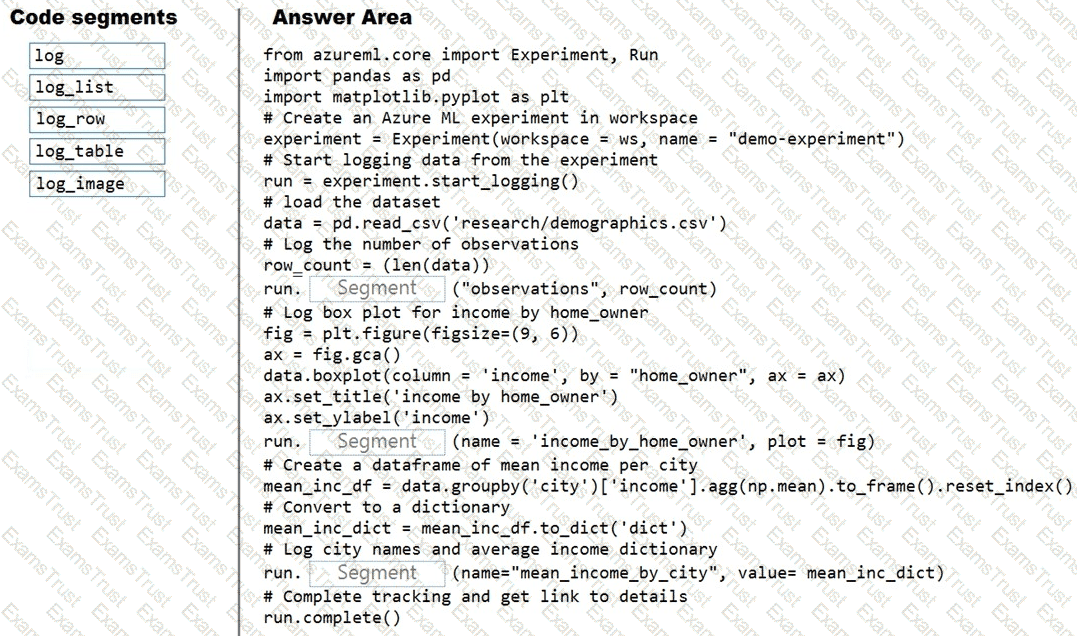
You create an experiment in Azure Machine Learning Studio. You add a training dataset that contains 10,000 rows. The first 9,000 rows represent class 0 (90 percent).
The remaining 1,000 rows represent class 1 (10 percent).
The training set is imbalances between two classes. You must increase the number of training examples for class 1 to 4,000 by using 5 data rows. You add the Synthetic Minority Oversampling Technique (SMOTE) module to the experiment.
You need to configure the module.
Which values should you use? To answer, select the appropriate options in the dialog box in the answer area.
NOTE: Each correct selection is worth one point.
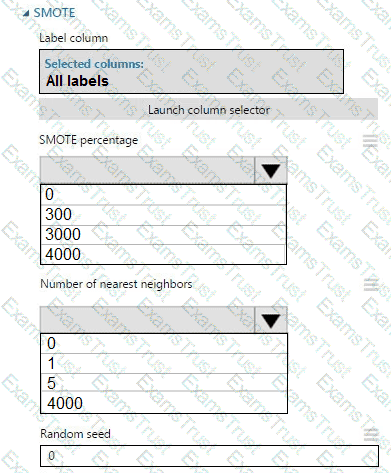
You use Azure Machine Learning to deploy a model as a real-time web service.
You need to create an entry script for the service that ensures that the model is loaded when the service starts and is used to score new data as it is received.
Which functions should you include in the script? To answer, drag the appropriate functions to the correct actions. Each function may be used once, more than once, or not at all. You may need to drag the split bar between panes or scroll to view content
NOTE: Each correct selection is worth one point.

You create a classification model with a dataset that contains 100 samples with Class A and 10,000 samples with Class B
The variation of Class B is very high.
You need to resolve imbalances.
Which method should you use?
You have a dataset that contains records of patients tested for diabetes. The dataset includes the patient s age.
You plan to create an analysis that will report the mean age value from the differentially private data derived from the dataset-
You need to identify the epsilon value to use in the analysis that minimizes the risk of exposing the actual data.
Which epsilon value should you use?
You are using an Azure Machine Learning workspace. You set up an environment for model testing and an environment for production.
The compute target for testing must minimize cost and deployment efforts. The compute target for production must provide fast response time, autoscaling of the deployed service, and support real-time inferencing.
You need to configure compute targets for model testing and production.
Which compute targets should you use? To answer, select the appropriate options in the answer area.
NOTE: Each correct selection is worth one point.
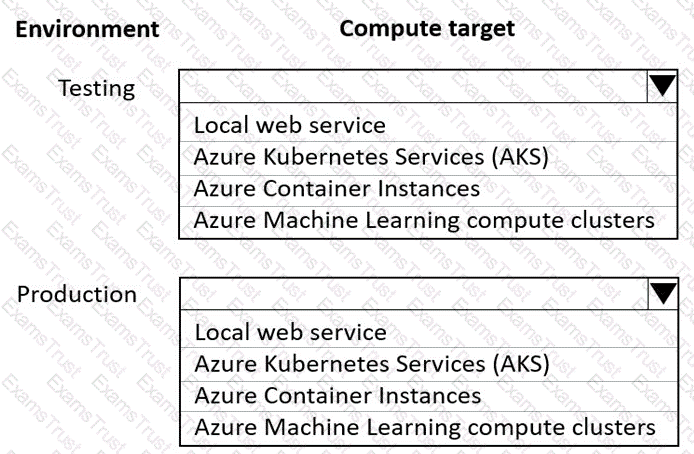
You use an Azure Machine Learning workspace. Azure Data Factor/ pipeline, and a dataset monitor that runs en a schedule to detect data drift.
You need to Implement an automated workflow to trigger when the dataset monitor detects data drift and launch the Azure Data Factory pipeline to update the dataset. The solution must minimize the effort to configure the workflow.
How should you configure the workflow? To answer select the appropriate options in the answer area.
NOTE: Each correct selection is worth one point.

You need to implement source control for scripts in an Azure Machine Learning workspace. You use a terminal window in the Azure Machine Learning Notebook tab
You must authenticate your Git account with SSH.
You need to generate a new SSH key.
Which four actions should you perform in sequence? To answer, move the appropriate actions from the list of actions to the answer area and arrange them m the correct order.

Note: This question is part of a series of questions that present the same scenario. Each question in the series contains a unique solution that might meet the stated goals. Some question sets might have more than one correct solution, while others might not have a correct solution.
After you answer a question in this section, you will NOT be able to return to it. As a result, these questions will not appear in the review screen.
An IT department creates the following Azure resource groups and resources:

The IT department creates an Azure Kubernetes Service (AKS)-based inference compute target named aks-cluster in the Azure Machine Learning workspace. You have a Microsoft Surface Book computer with a GPU. Python 3.6 and Visual Studio Code are installed.
You need to run a script that trains a deep neural network (DNN) model and logs the loss and accuracy metrics.
Solution: Install the Azure ML SDK on the Surface Book. Run Python code to connect to the workspace. Run the training script as an experiment on the aks-cluster compute target.
Does the solution meet the goal?
You create an Azure Machine Learning workspace named workspaces. You create a Python SDK v2 notebook to perform custom model training in workspace1. You need to run the notebook from Azure Machine Learning Studio in workspace1. What should you provision first?
You develop a Prompt flow in an Azure Al Foundry project.
You plan to use variants and invoke a custom API in the flow.
You need to add tools to the flow that will implement the planned functionality. Your solution must minimize development efforts.
Which tools should you use? To answer, move the appropriate tools to the correct functionalities. You may use each tool once, more than once, or not at all. You may need to move the split bar between panes or scroll to view content.
NOTE: Each correct selection is worth one point.

You create an Azure Machine Learning workspace. You train a classification model by using automated machine learning (automated ML) in Azure Machine Learning studio. The training data contains multiple classes that have significantly different numbers of samples.
You must use a metric type to avoid labeling negative samples as positive and an averaging method that will minimize the class imbalance.
You need to configure the metric type and the averaging method.
Which configurations should you use? To answer, select the appropriate options in the answer area.
NOTE: Each correct selection is worth one point.

The finance team asks you to train a model using data in an Azure Storage blob container named finance-data.
You need to register the container as a datastore in an Azure Machine Learning workspace and ensure that an error will be raised if the container does not exist.
How should you complete the code? To answer, select the appropriate options in the answer area.
NOTE: Each correct selection is worth one point.
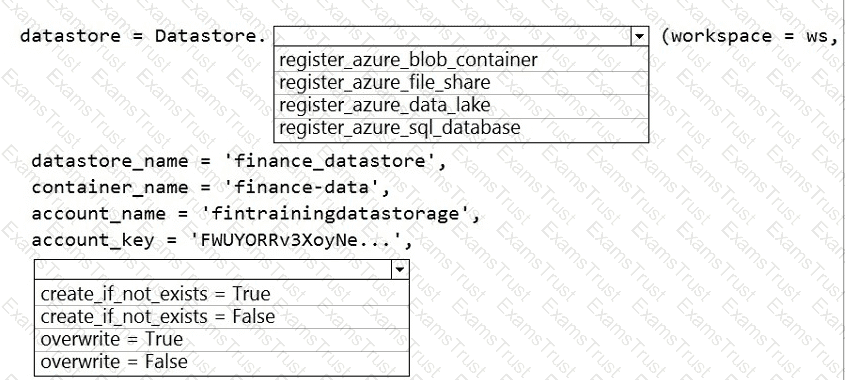
A set of CSV files contains sales records. All the CSV files have the same data schema.
Each CSV file contains the sales record for a particular month and has the filename sales.csv. Each file in stored in a folder that indicates the month and year when the data was recorded. The folders are in an Azure blob container for which a datastore has been defined in an Azure Machine Learning workspace. The folders are organized in a parent folder named sales to create the following hierarchical structure:

At the end of each month, a new folder with that month’s sales file is added to the sales folder.
You plan to use the sales data to train a machine learning model based on the following requirements:
You must define a dataset that loads all of the sales data to date into a structure that can be easily converted to a dataframe.
You must be able to create experiments that use only data that was created before a specific previous month, ignoring any data that was added after that month.
You must register the minimum number of datasets possible.
You need to register the sales data as a dataset in Azure Machine Learning service workspace.
What should you do?
You manage an Azure OpenAI Service deployment of the gpt-4o-mini base model.
You plan to fine-tune the deployed model by using OpenAI Python la code. In the code, you import all required Python libraries and create a sample training data set.
You need to complete the next section of the code to estimate the cost of fine-tuning by using the sample training data set.
How should you complete the code section? To answer, select the appropnate options in the answer area.
NOTE: Each correct selection is worth one point.

You download a .csv file from a notebook in an Azure Machine Learning workspace to a data/sample.csv folder on a compute instance. The file contains 10,000 records. You must generate the summary statistics for the data in the file. The statistics must include the following for each numerical column:
• number of non-empty values
• average value
• standard deviation
• minimum and maximum values
• 25th. 50th. and 75th percentiles
You need to complete the Python code that will generate the summary statistics.
Which code segments should you use? To answer, select the appropriate options in the answer area.
NOTE: Each correct selection is worth one point.

You run a script as an experiment in Azure Machine Learning.
You have a Run object named run that references the experiment run. You must review the log files that were generated during the experiment run.
You need to download the log files to a local folder for review.
Which two code segments can you run to achieve this goal? Each correct answer presents a complete solution.
NOTE: Each correct selection is worth one point.
You have an Azure Machine Learning workspace. You plan to tune model hyperparameters by using a sweep job.
You need to find a sampling method that supports early termination of low-performance jobs and continuous hyperpara meters.
Solution: Use the Sobol sampling method over the hyperpara meter space.
Does the solution meet the goal?
You create a Python script named train.py and save it in a folder named scripts. The script uses the scikit-learn framework to train a machine learning model.
You must run the script as an Azure Machine Learning experiment on your local workstation.
You need to write Python code to initiate an experiment that runs the train.py script.
How should you complete the code segment? To answer, select the appropriate options in the answer area.
NOTE: Each correct selection is worth one point.
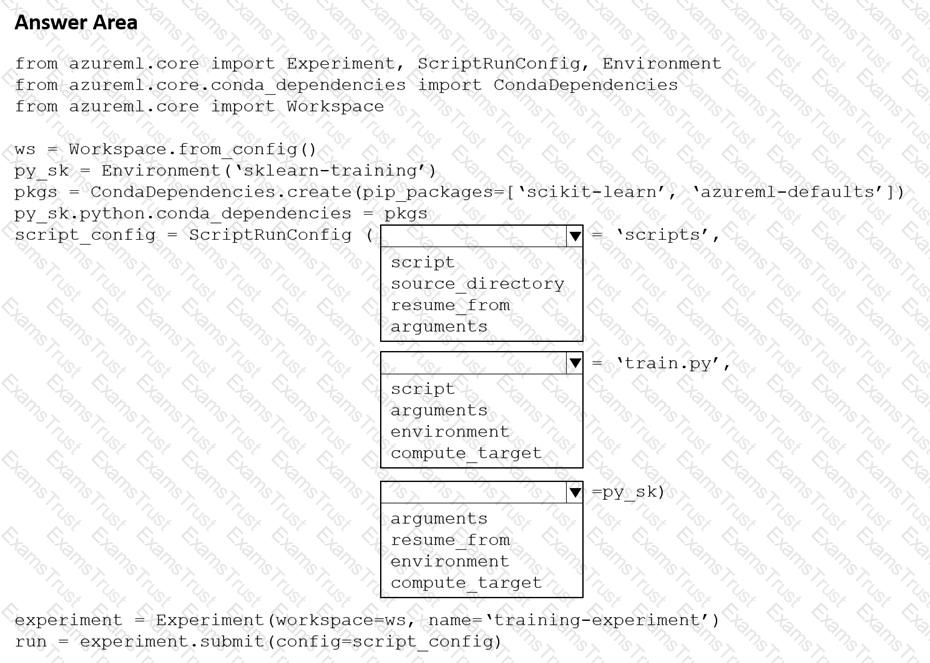
Note: This question is part of a series of questions that present the same scenario. Each question in the series contains a unique solution that might meet the stated goals. Some question sets might have more than one correct solution, while others might not have a correct solution.
After you answer a question in this section, you will NOT be able to return to it. As a result, these questions will not appear in the review screen.
You use Azure Machine Learning designer to load the following datasets into an experiment:
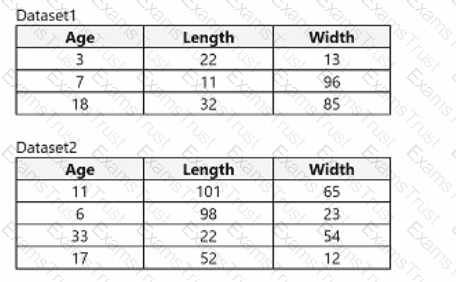
You need to create a dataset that has the same columns and header row as the input datasets and contains all rows from both input datasets.
Solution: Use the Join Data module.
Does the solution meet the goal?
You manage an Azure Machine Learning workspace named Workspace1 and an Azure Blob Storage accessed by using the URL
You plan to create an Azure Blob datastore in Workspace1. The datastore must target the Blob Storage by using Azure Machine Learning Python SDK v2. Access authorization to the datastore must be limited to a specific amount of time.
You need to select the parameters of the Azure Blob Datastore class that will point to the target datastore and authorize access to it.
Which parameters should you use? To answer, select the appropriate options in the answer area
NOTE: Each correct selection is worth one point.

You are planning to register a trained model in an Azure Machine Learning workspace.
You must store additional metadata about the model in a key-value format. You must be able to add new metadata and modify or delete metadata after creation.
You need to register the model.
Which parameter should you use?
An organization creates and deploys a multi-class image classification deep learning model that uses a set of labeled photographs.
The software engineering team reports there is a heavy inferencing load for the prediction web services during the summer. The production web service for the model fails to meet demand despite having a fully-utilized compute cluster where the web service is deployed.
You need to improve performance of the image classification web service with minimal downtime and minimal administrative effort.
What should you advise the IT Operations team to do?
You are running a training experiment on remote compute in Azure Machine Learning.
The experiment is configured to use a conda environment that includes the mlflow and azureml-contrib-run packages.
You must use MLflow as the logging package for tracking metrics generated in the experiment.
You need to complete the script for the experiment.
How should you complete the code? To answer, select the appropriate options in the answer area.
NOTE: Each correct selection is worth one point.
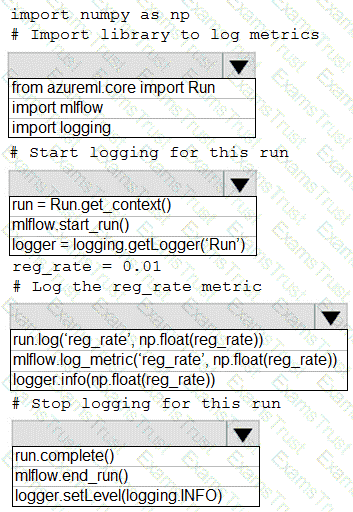
You create an MLflow model
You must deploy the model to Azure Machine Learning for batch inference.
You need to create the batch deployment.
Which two components should you use? Each correct answer presents a complete solution.
NOTE: Each correct selection is worth one point
: 218 HOTSPOT
You collect data from a nearby weather station. You have a pandas dataframe named weather_df that includes the following data:

The data is collected every 12 hours: noon and midnight.
You plan to use automated machine learning to create a time-series model that predicts temperature over the next seven days. For the initial round of training, you want to train a maximum of 50 different models.
You must use the Azure Machine Learning SDK to run an automated machine learning experiment to train these models.
You need to configure the automated machine learning run.
How should you complete the AutoMLConfig definition? To answer, select the appropriate options in the answer area.
NOTE: Each correct selection is worth one point.
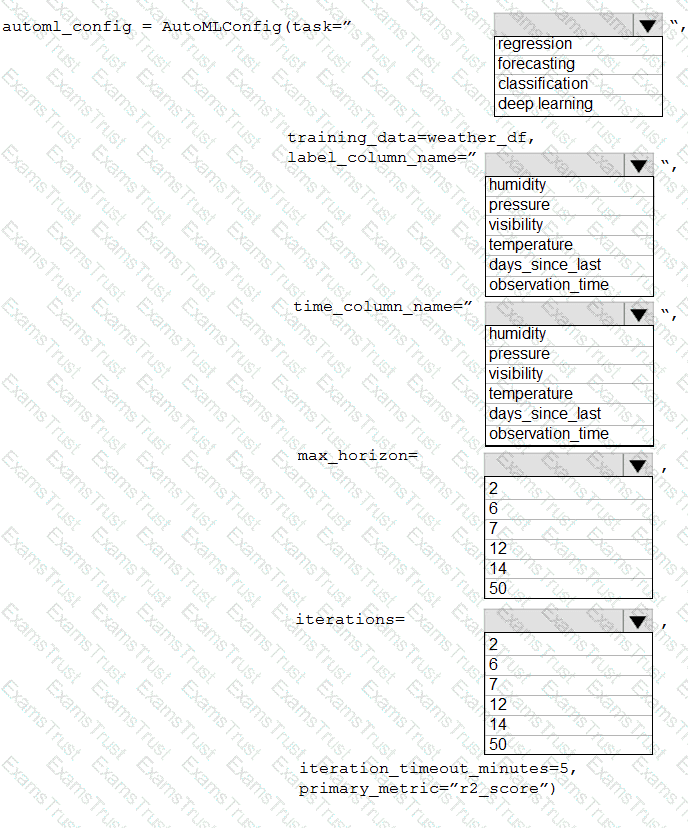
You have a dataset that is stored m an Azure Machine Learning workspace.
You must perform a data analysis for differentiate privacy by using the SmartNoise SDK.
You need to measure the distribution of reports for repeated queries to ensure that they are balanced
Which type of test should you perform?
You manage an Azure Machine Learning workspace named Workspace1.
You plan to create a pipeline in the Azure Machine Learning Studio designer. The pipeline must include a custom component You need to ensure the custom component can be used in the pipeline. What should you do first.
You use an Azure Machine Learning workspace.
You must monitor cost at the endpoint and deployment level.
You have a trained model that must be deployed as an online endpoint. Users must authenticate by using Microsoft Entra ID.
What should you do?
You are creating a binary classification by using a two-class logistic regression model.
You need to evaluate the model results for imbalance.
Which evaluation metric should you use?
Note: This question is part of a series of questions that present the same scenario. Each question in the series contains a unique solution that might meet the stated goals. Some question sets might have more than one correct solution, while others might not have a correct solution.
After you answer a question in this section, you will NOT be able to return to it. As a result, these questions will not appear in the review screen.
You are a data scientist using Azure Machine Learning Studio.
You need to normalize values to produce an output column into bins to predict a target column.
Solution: Apply an Equal Width with Custom Start and Stop binning mode.
Does the solution meet the goal?
You are developing code to analyse a dataset that includes age information for a large group of diabetes patients. You create an Azure Machine Learning workspace and install all required libraries. You set the privacy budget to 1.0).
You must analyze the dataset and preserve data privacy. The code must run twice before the privacy budget is depleted.
You need to complete the code.
Which values should you use? To answer, select the appropriate options m the answer area.
NOTE: Each correct selection is worth one point.
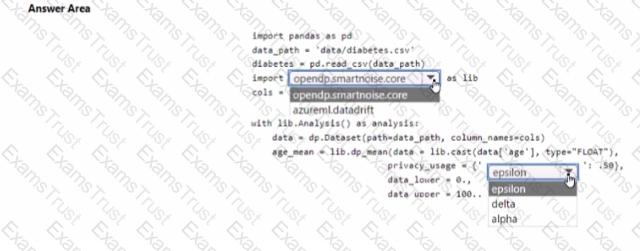
You create an Azure Databricks workspace and a linked Azure Machine Learning workspace.
You have the following Python code segment in the Azure Machine Learning workspace:
import mlflow
import mlflow.azureml
import azureml.mlflow
import azureml.core
from azureml.core import Workspace
subscription_id = 'subscription_id'
resourse_group = 'resource_group_name'
workspace_name = 'workspace_name'
ws = Workspace.get(name=workspace_name,
subscription_id=subscription_id,
resource_group=resource_group)
experimentName = "/Users/{user_name}/{experiment_folder}/{experiment_name}"
mlflow.set_experiment(experimentName)
uri = ws.get_mlflow_tracking_uri()
mlflow.set_tracking_uri(uri)
Instructions: For each of the following statements, select Yes if the statement is true. Otherwise, select No.
NOTE: Each correct selection is worth one point.

You are creating a machine learning model that can predict the species of a penguin from its measurements. You have a file that contains measurements for free species of penguin in comma delimited format.
The model must be optimized for area under the received operating characteristic curve performance metric averaged for each class.
You need to use the Automated Machine Learning user interface in Azure Machine Learning studio to run an experiment and find the best performing model.
Which five actions should you perform in sequence? To answer, move the appropriate actions from the list of actions to the answer area and arrange them in the collect order.

You train a machine learning model.
You must deploy the model as a real-time inference service for testing. The service requires low CPU utilization and less than 48 MB of RAM. The compute target for the deployed service must initialize automatically while minimizing cost and administrative overhead.
Which compute target should you use?
You previously deployed a model that was trained using a tabular dataset named training-dataset, which is based on a folder of CSV files.
Over time, you have collected the features and predicted labels generated by the model in a folder containing a CSV file for each month. You have created two tabular datasets based on the folder containing the inference data: one named predictions-dataset with a schema that matches the training data exactly, including the predicted label; and another named features-dataset with a schema containing all of the feature columns and a timestamp column based on the filename, which includes the day, month, and year.
You need to create a data drift monitor to identify any changing trends in the feature data since the model was trained. To accomplish this, you must define the required datasets for the data drift monitor.
Which datasets should you use to configure the data drift monitor? To answer, drag the appropriate datasets to the correct data drift monitor options. Each source may be used once, more than once, or not at all. You may need to drag the split bar between panes or scroll to view content.
NOTE: Each correct selection is worth one point.

Note: This question is part of a series of questions that present the same scenario. Each question in the series contains a unique solution that might meet the stated goals. Some question sets might have more than one correct solution, while others might not have a correct solution.
After you answer a question in this section, you will NOT be able to return to it. As a result, these questions will not appear in the review screen.
You are using Azure Machine Learning Studio to perform feature engineering on a dataset.
You need to normalize values to produce a feature column grouped into bins.
Solution: Apply an Entropy Minimum Description Length (MDL) binning mode.
Does the solution meet the goal?
You train and register a machine learning model. You create a batch inference pipeline that uses the model to generate predictions from multiple data files.
You must publish the batch inference pipeline as a service that can be scheduled to run every night.
You need to select an appropriate compute target for the inference service.
Which compute target should you use?
You deploy a model in Azure Container Instance.
You must use the Azure Machine Learning SDK to call the model API.
You need to invoke the deployed model using native SDK classes and methods.
How should you complete the command? To answer, select the appropriate options in the answer areas.
NOTE: Each correct selection is worth one point.
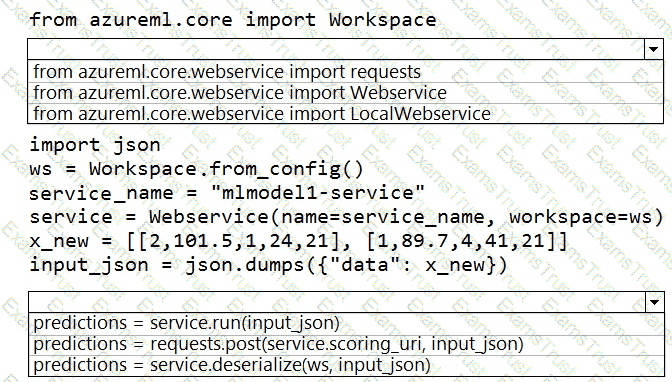
You create a Python script that runs a training experiment in Azure Machine Learning. The script uses the Azure Machine Learning SDK for Python.
You must add a statement that retrieves the names of the logs and outputs generated by the script.
You need to reference a Python class object from the SDK for the statement.
Which class object should you use?
Note: This question is part of a series of questions that present the same scenario. Each question in the series contains a unique solution that might meet the stated goals. Some question sets might have more than one correct solution, while others might not have a correct solution.
After you answer a question in this section, you will NOT be able to return to it. As a result, these
questions will not appear in the review screen.
You are creating a model to predict the price of a student’s artwork depending on the following variables: the student’s length of education, degree type, and art form.
You start by creating a linear regression model.
You need to evaluate the linear regression model.
Solution: Use the following metrics: Accuracy, Precision, Recall, F1 score and AUC.
Does the solution meet the goal?
You manage an Azure Machine Learning workspace. The development environment is configured with a Serverless Spark compute in Azure Machine Learning Notebooks.
You perform interactive data wrangling to clean up the Titanic dataset and store it as a new dataset (Line numbers are used for reference only.)

For each of the following statements, select Yes if the statement is true Otherwise, select No
NOTE: Bach correct selection is worth one point.

You plan to use Hyperdrive to optimize the hyperparameters selected when training a model. You create the following code to define options for the hyperparameter experiment


For each of the following statements, select Yes if the statement is true. Otherwise, select No. NOTE: Each correct selection is worth one point.

You manage an Azure Machine Learning workspace.
You plan to train a natural language processing (NLP) model that will assign labels 'or designated tokens in unstructured text
You need to configure the NLP task by using automated machine learning.
Which configuration values should you use? To answer, select the appropriate options in the answer area.
NOTE Each correct selection is worth one point.

You need to produce a visualization for the diagnostic test evaluation according to the data visualization requirements.
Which three modules should you recommend be used in sequence? To answer, move the appropriate modules from the list of modules to the answer area and arrange them in the correct order.
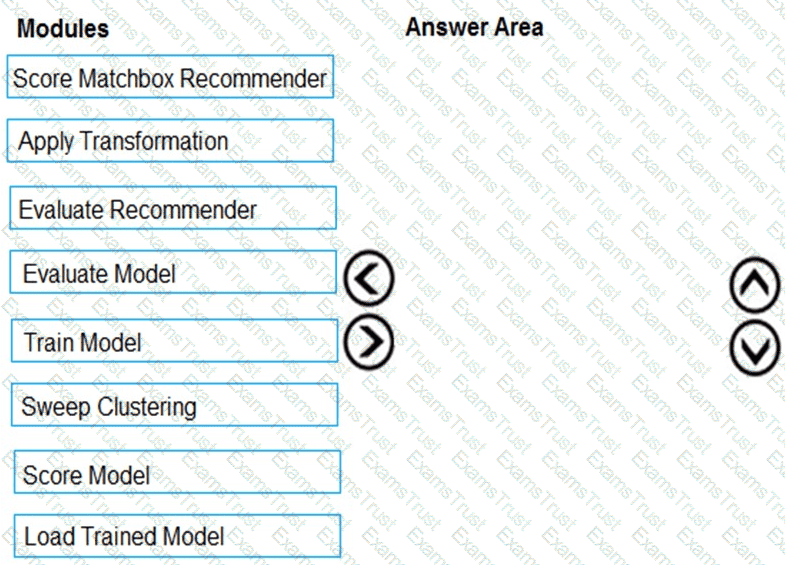
You need to implement early stopping criteria as suited in the model training requirements.
Which three code segments should you use to develop the solution? To answer, move the appropriate code segments from the list of code segments to the answer area and arrange them in the correct order.
NOTE: More than one order of answer choices is correct. You will receive credit for any of the correct orders you select.
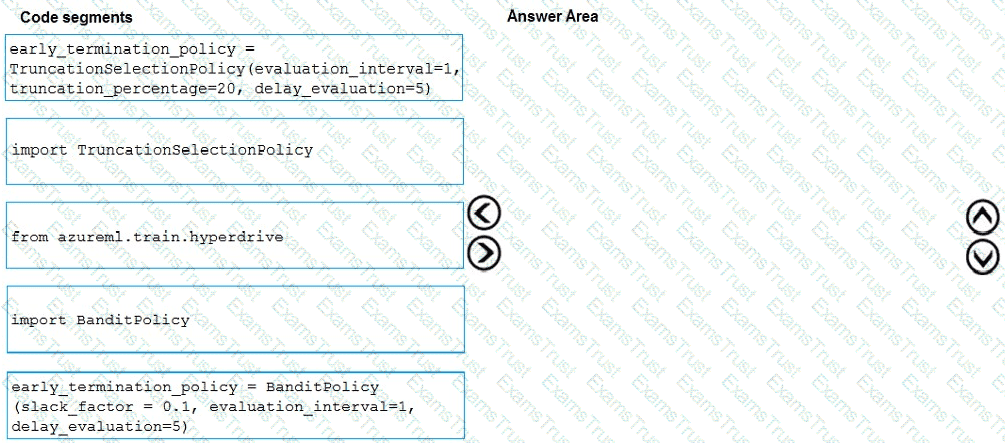
You need to configure the Feature Based Feature Selection module based on the experiment requirements and datasets.
How should you configure the module properties? To answer, select the appropriate options in the dialog box in the answer area.
NOTE: Each correct selection is worth one point.
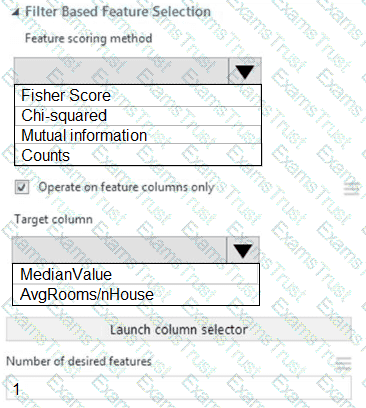
You need to correct the model fit issue.
Which three actions should you perform in sequence? To answer, move the appropriate actions from the list of actions to the answer area and arrange them in the correct order.
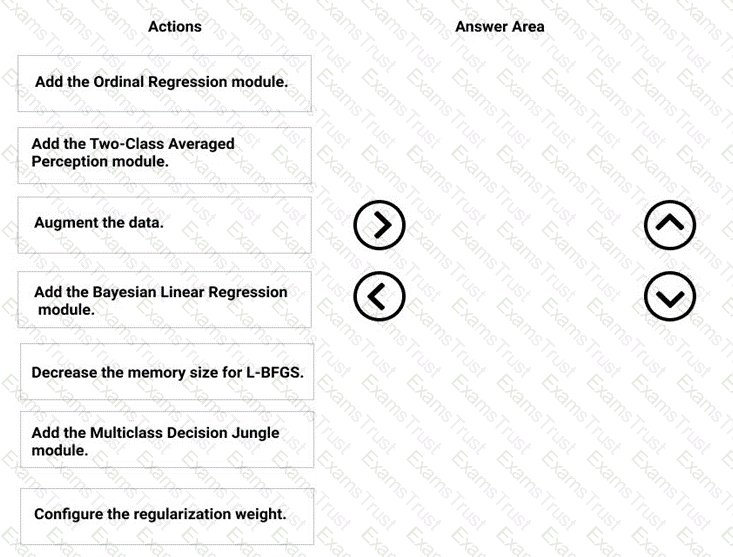
You need to visually identify whether outliers exist in the Age column and quantify the outliers before the outliers are removed.
Which three Azure Machine Learning Studio modules should you use in sequence? To answer, move the appropriate modules from the list of modules to the answer area and arrange them in the correct order.
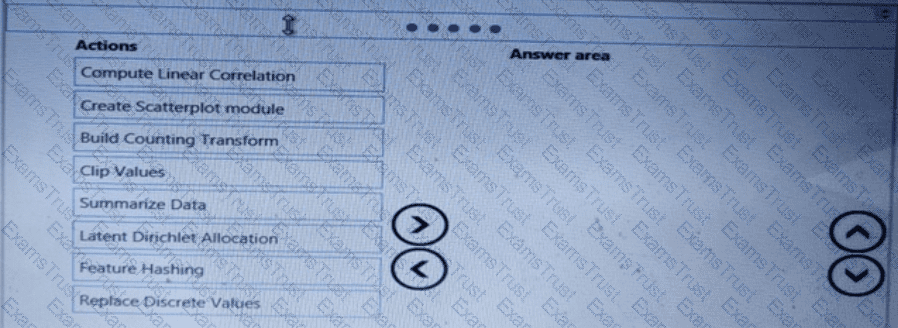
You need to select a feature extraction method.
Which method should you use?
You need to set up the Permutation Feature Importance module according to the model training requirements.
Which properties should you select? To answer, select the appropriate options in the answer area.
NOTE: Each correct selection is worth one point.
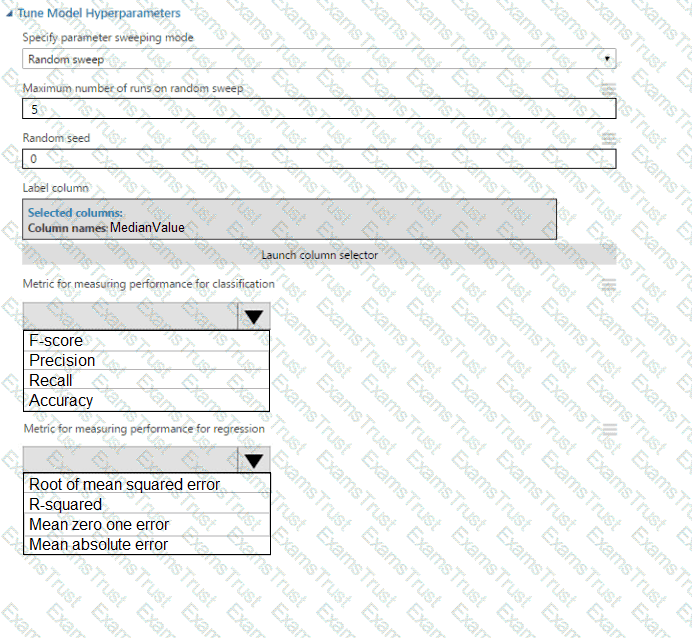
You need to configure the Edit Metadata module so that the structure of the datasets match.
Which configuration options should you select? To answer, select the appropriate options in the answer area.
NOTE: Each correct selection is worth one point.
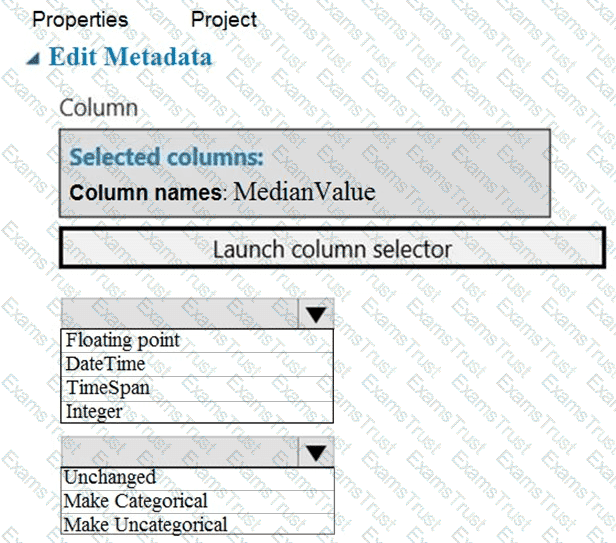
You need to replace the missing data in the AccessibilityToHighway columns.
How should you configure the Clean Missing Data module? To answer, select the appropriate options in the answer area.
NOTE: Each correct selection is worth one point.
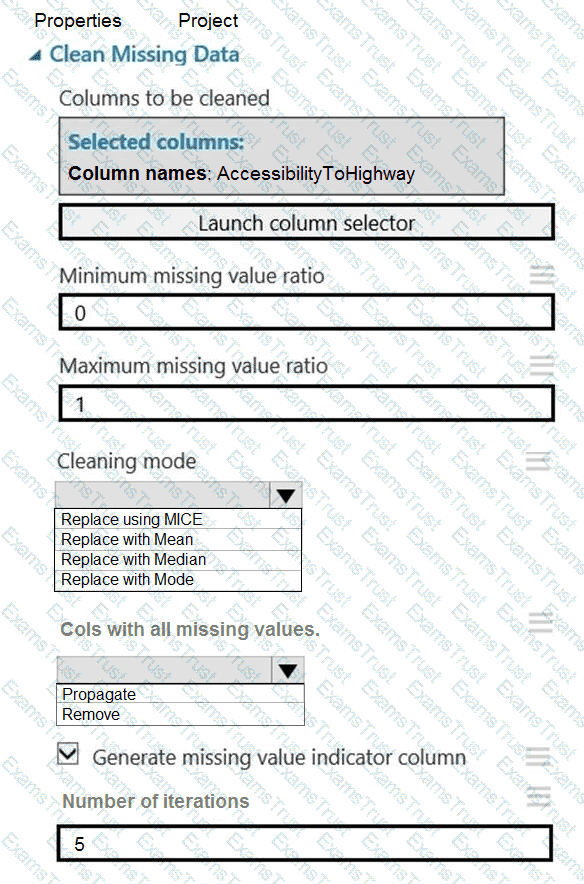
You need to identify the methods for dividing the data according to the testing requirements.
Which properties should you select? To answer, select the appropriate options in the answer area.
NOTE: Each correct selection is worth one point.
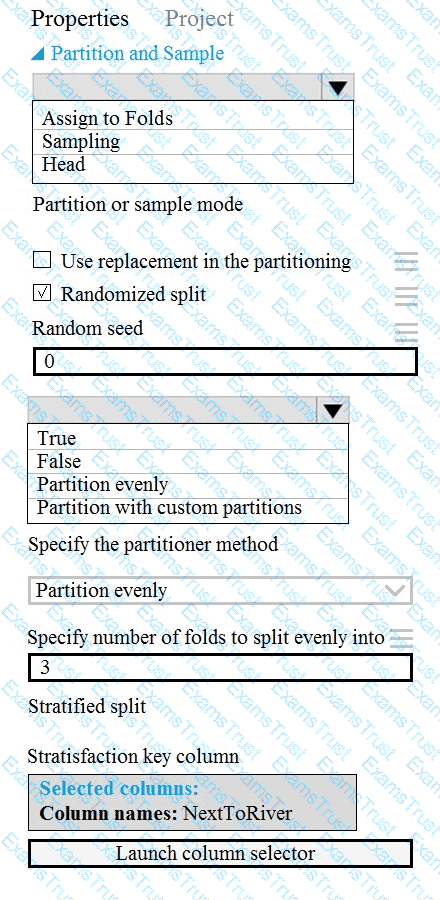
You need to identify the methods for dividing the data according, to the testing requirements.
Which properties should you select? To answer, select the appropriate option-, m the answer area. NOTE: Each correct selection is worth one point.
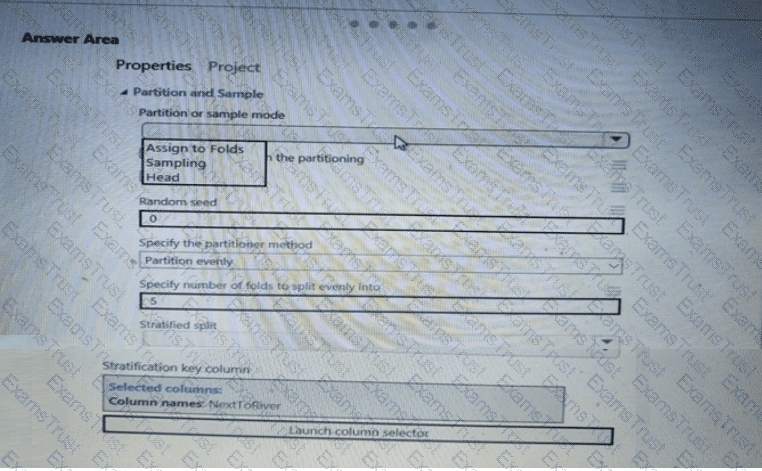
You need to select a feature extraction method.
Which method should you use?
You need to configure the Permutation Feature Importance module for the model training requirements.
What should you do? To answer, select the appropriate options in the dialog box in the answer area.
NOTE: Each correct selection is worth one point.
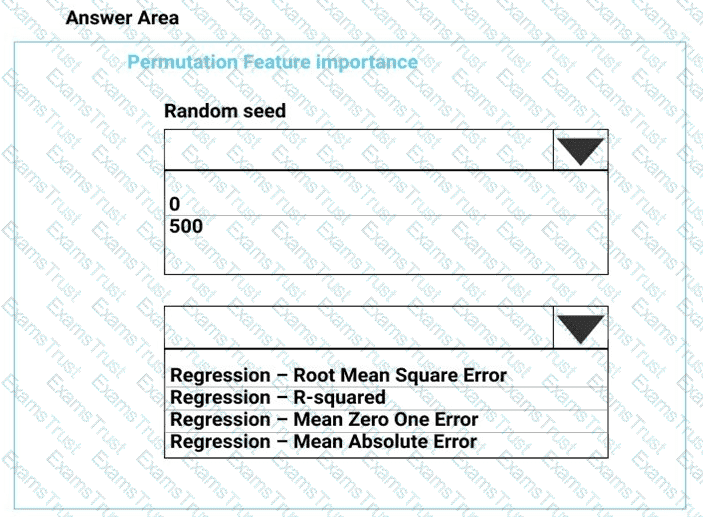
You need to define a process for penalty event detection.
Which three actions should you perform in sequence? To answer, move the appropriate actions from the list of actions to the answer area and arrange them in the correct order.
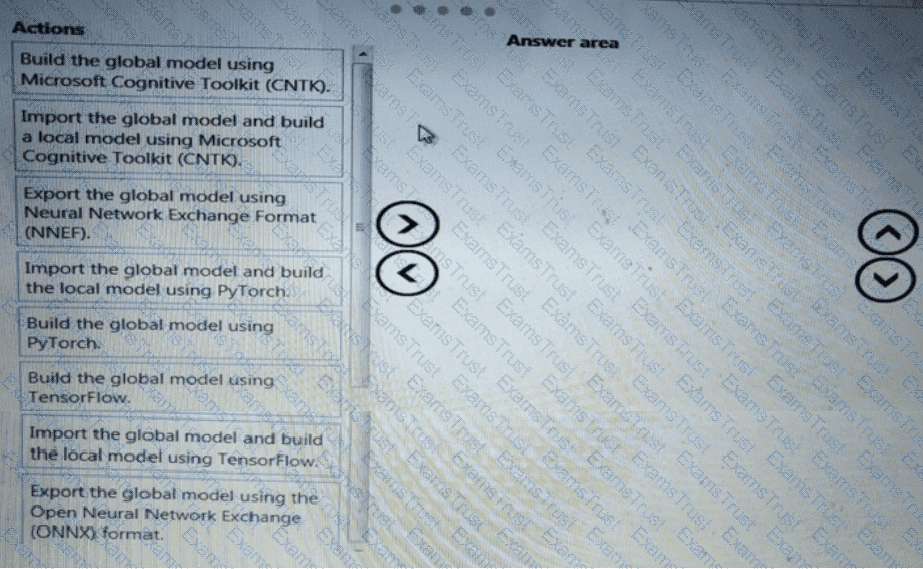
You need to build a feature extraction strategy for the local models.
How should you complete the code segment? To answer, select the appropriate options in the answer area.
NOTE: Each correct selection is worth one point.
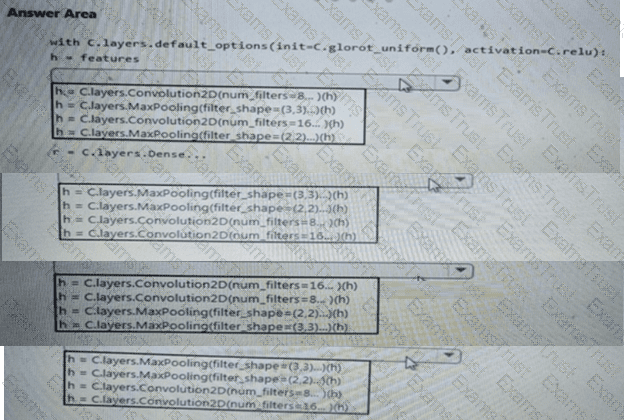
You need to implement a feature engineering strategy for the crowd sentiment local models.
What should you do?
You need to implement a new cost factor scenario for the ad response models as illustrated in the
performance curve exhibit.
Which technique should you use?
You need to define an evaluation strategy for the crowd sentiment models.
Which three actions should you perform in sequence? To answer, move the appropriate actions from the list of actions to the answer area and arrange them in the correct order.
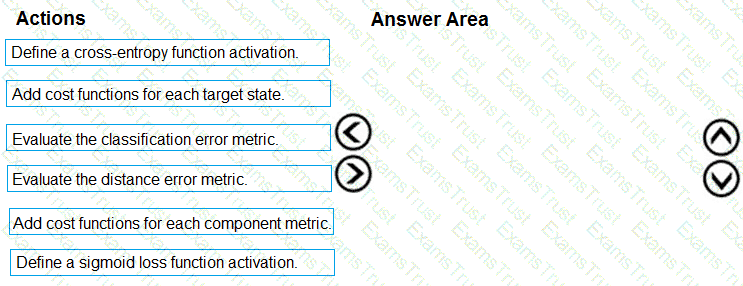
You need to implement a model development strategy to determine a user’s tendency to respond to an ad.
Which technique should you use?
You need to use the Python language to build a sampling strategy for the global penalty detection models.
How should you complete the code segment? To answer, select the appropriate options in the answer area.
NOTE: Each correct selection is worth one point.
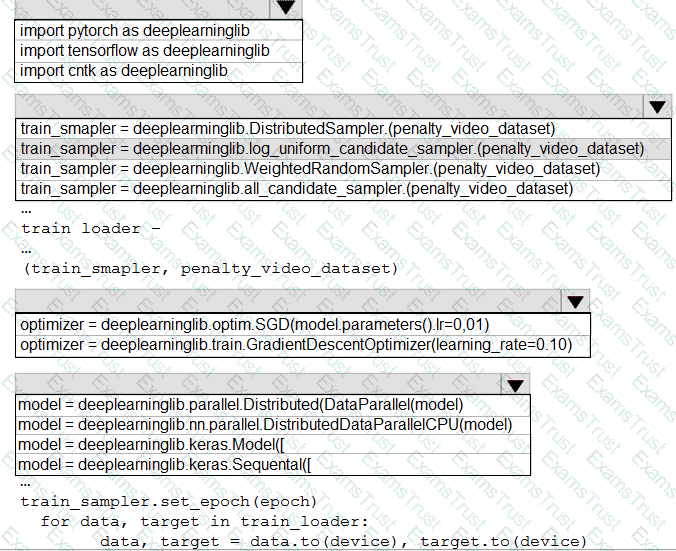
You need to modify the inputs for the global penalty event model to address the bias and variance issue.
Which three actions should you perform in sequence? To answer, move the appropriate actions from the list of actions to the answer area and arrange them in the correct order.
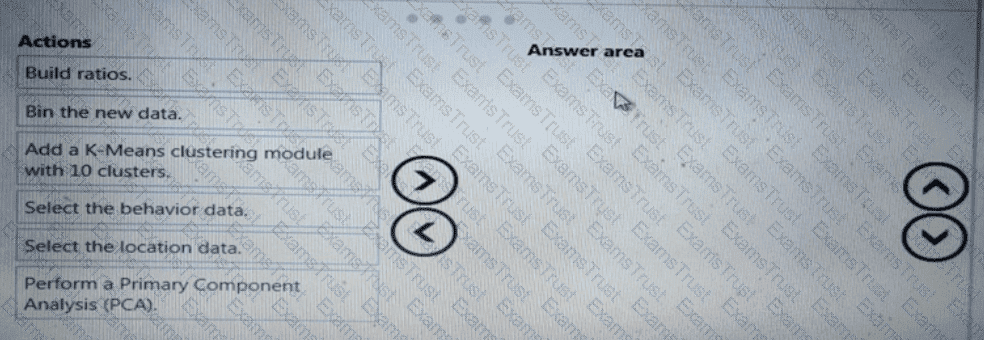
You need to implement a scaling strategy for the local penalty detection data.
Which normalization type should you use?
You need to select an environment that will meet the business and data requirements.
Which environment should you use?
You need to define an evaluation strategy for the crowd sentiment models.
Which three actions should you perform in sequence? To answer, move the appropriate actions from the list of actions to the answer area and arrange them in the correct order.
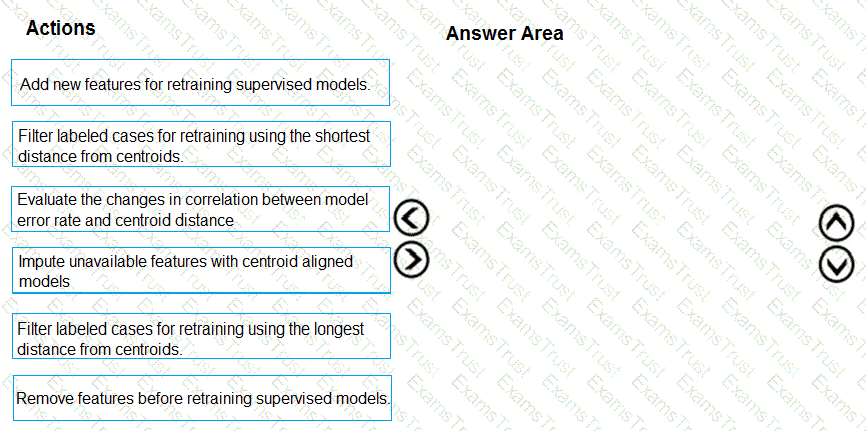
You need to define a modeling strategy for ad response.
Which three actions should you perform in sequence? To answer, move the appropriate actions from the list of actions to the answer area and arrange them in the correct order.
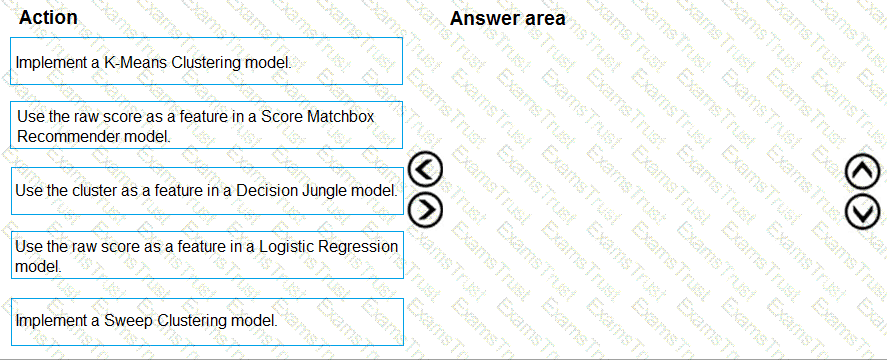
You need to resolve the local machine learning pipeline performance issue. What should you do?
You need to define a process for penalty event detection.
Which three actions should you perform in sequence? To answer, move the appropriate actions from the list of actions to the answer area and arrange them in the correct order.
